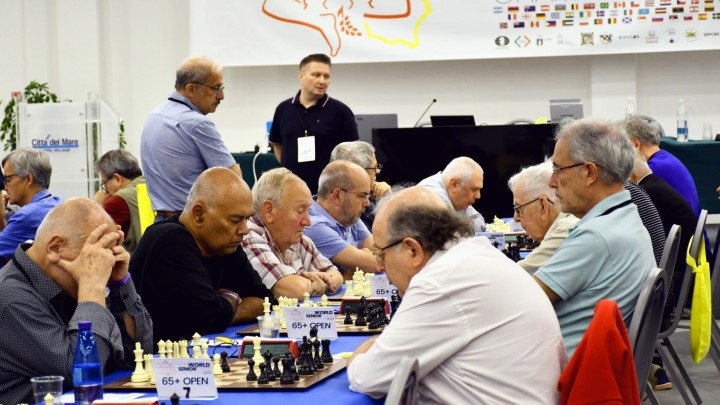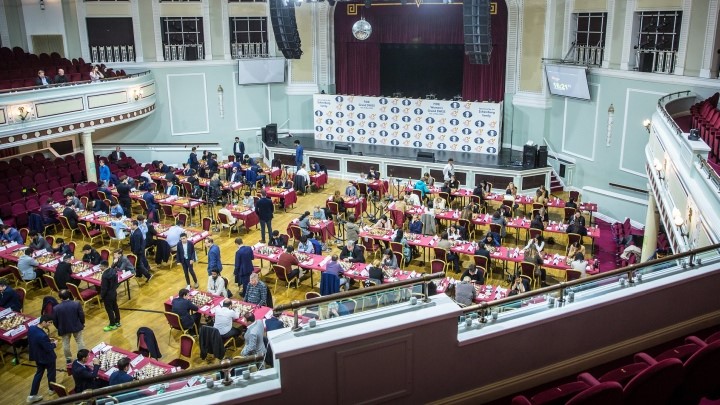FIDE World Senior Championship 2023 kicks off in Terrasini, Italy

The 31st edition of the FIDE World Senior Championship kicked off in Terrasini, Italy on October 25, 2023. Italy has already hosted this tournament eight times, and this year, the event is taking place on the beautiful island of Sicily. Organized by FIDE and the Italian Chess Federation together with UniChess and Accademia Scacchistica Monrealese, the competition brought together 271 players from 53 different national federations battling for the title of the World Senior Champion in the categories Open 50+, Open 65+ and Women. FIDE Events Commission decided to merge the Women 50+ and 65+ categories into a single 11-round Swiss tournament as proposed by the organizing committee. Prizes will be awarded separately to the best players in the Women 50+ and Women 65+ categories according to the final standings. The prize fund for this year’s championship hit a record high of €42,500. The first day started with a technical meeting, followed by a brief opening ceremony held by IA Ashot Vardapetyan, FIDE Delegate and ECU Vicepresident Eva Repkova and GM Roberto Mogranzini. After WGM and IM Eva Repkova made the first ceremonial move on the first board in the game between GM Gaprindashvili Nona (GEO) and WFM Kierzek Mira (GER) in the women’s category, the competition went underway. The tournament is officiated by the chief arbiter, IA Ashot Vardapetyan (ARM). All rounds will be broadcast live and can be watched online. The top-rated participants are GM Michael Adams (ENG, 2670) in the Open 50+ category, GM Jhon Nunn (ENG, 2560) in the Open 65+ category and GM Nona Gaprindashvili (GEO, 2267) in the Women category. Official website: worldseniorchess2023.com/ Complete results: https://chess-results.com/tnr832133.aspx?lan=16 Photos: Patricia Claros Aguilar
FIDE Grand Swiss 2023: Day 1 Recap

The difference between the FIDE Grand Swiss and any other Swiss tournament is that nobody gets a weak opponent in round one. Usually, at open Swiss events, the favourites can expect weaker opponents in the first few rounds before facing each other. However, at the Isle of Man, challenging games started immediately. Therefore, it’s not surprising that there were some draws and wins by the underdogs. Still, these are not surprises, as everybody can beat everybody in this tournament. Top seed Fabiano Caruana surprised his opponent Ivan Saric with the Sicilian Najdorf, a variation he doesn’t usually play. Most likely, his intention was either to conceal his ideas in the openings he normally plays or to try a new opening and/or to confuse his future opponents in the Candidates. Whatever his reasons, it worked to perfection, as Fabiano obtained a promising position very quickly. Black’s usual choices here are 8…Nc6 or 8…0-0. Caruana’s 8…Nbd7!? is a rare continuation, but perhaps that will change after this game. After the natural 9.Qd2 Black continued in provocative style with 9…b5, inviting 10.a4 b4 11.Nce2, and here, the second-rated player in the world sacrificed a pawn with 11…d5! Saric spent more than 25 minutes on his reply and chose the sub-optimal 12.Bh6?! Taking the pawn with 12.Qxb4 offers Black good compensation after either 12…Qc7 or 12…Rb8. If White wanted to play Bh6, it was better to insert the exchange on d5 first and then play Bh6, which would have led to an unclear position. After the immediate exchange of bishops, Black took on e4 and created an isolated pawn on e4, which gave him a structural advantage. Black has a better structure, but White can certainly fight here. However, instead of 17.c3 or even going for the endgame with 17.Qf4, where White’s activity should keep him out of danger, Saric over-optimistically sacrificed an exchange with 17.Rxf6?! exf6 18.Qg7 Rf8 19.Qxf6, but after the cold-blooded 19…Bb7, threatening …Rd8 or …Qd8, he had little to show for it. Caruana masterfully controlled the tactics and wrapped up the game in 30 moves. Levon Aronian has been out of the top 10 for some time now and recently didn’t do so well at the US Championship. Playing young and ambitious Max Warmerdam with the black pieces, he seemed invigorated and introduced a very interesting novel direction as early as move five (!) in a popular line in the English Opening. The usual move here is the natural 5…Nxe5, played by Levon on more than one occasion. Instead of that, Aronian played the surprising 5…Qe7!?, which is a long-term pawn sacrifice. After 6.Nxc6 dxc6 7.d3 White is solid, so where’s the compensation? Not surprisingly, the engine doesn’t see anything troublesome for White, but in practice, things are far from simple, especially when seeing the position for the first time. It does resemble the notorious Stafford Gambit, the difference being the pawn on c4 instead of c2. Just compare it with the position from the Stafford Gambit, arising after 1.e4 e5 2.Nf3 Nf6 3.Nxe5 Nc6?! 4.Nxc6 dxc6 5.d3 Bc5. White continued with natural moves, but this seemed to be all preparation by Aronian, who continued to play fast, making the engine’s preferred moves. Soon enough, the engine gave Black full compensation, with the evaluation hovering around 0.00. The critical position arose after Aronian’s 13th move when White should have accepted Black’s piece sacrifice, but since it seemed very risky, he declined it. Here, Max should have played 14.d4! Rxd4 15.Rf1 though after 15…Rd3 things look scary for White; even objectively, Black isn’t worse. Unfortunately, already under a lot of pressure, Warmerdam wanted to bail out quickly and went for 14.Nxe4?! Rxf4 15.0-0-0 Rxg4 when material was equal, but Black was better thanks to White’s weak pawn on d3. Aronian managed to convert his positional advantage with surprising ease. Hikaru Nakamura was in trouble early, which is surprising as his opening preparation is usually top-notch. He was in danger of losing but showed his signature defensive grit and managed to draw against Rasmus Svane. A notable duel in the first round was between Vasyl Ivanchuk and Ihor Samunenkov. Both from Ukraine, they are separated by 40 (!) years: Ivanchuk was born in 1969, and Samunenkov in 2009. Ivanchuk posed all the questions in their game, trying to squeeze something out from a position where his opponent had an isolated pawn on d5. The 14-year-old defended with admirable tenacity and managed to draw in spite of the veteran’s pressing for more than 60 moves. In the women’s section, the top three favourites, Aleksandra Goryachkina, Aleksandra Kosteniuk and Mariya Muzychuk, all drew. While Kosteniuk and Muzychuk didn’t have real winning chances, Goryachkina outplayed Anna Matnadze in her trademark positional fashion and obtained a winning position, only to blunder her rook and end up losing an exchange! Then it was Matnadze’s turn to miss her golden opportunity, and the game ended in a draw. Elizabeth Paehtz started with a magnificent attack to checkmate Alice Lee in a miniature. It was a tough blow for the 14-year-old prodigy from the USA and a promising start for one of the tournament favourites. In a sharp English Opening, both players seemed out of the book early on. White quickly obtained a huge lead in development but gave her opponent a chance to limit the damage. Finishing the development with 12.Bg2! would have been decisive, while White’s 12.Nxe4?! allowed Black a sudden chance. Alice should have played 12…Bxd2 13.Nxd2 a5! Intending 14…a4-a3. This is very counter-intuitive; lagging back in development, Black goes for counterplay with the a-pawn, neglecting it even more! But it works, and that’s what counts in modern chess… Lee took the knight, but after 12…Qxe4? 13.Bxa5 the threat of Rd8 was decisive. After 13…Be6 14.Bg2! Qe5 15.Rd8 Kf7 16.Qa3 with Qf8 to come, White already had a crushing attack. The final position speaks volumes about the importance of piece development in the opening. Black resigned in view of 23…g4 24.Qxf7# 1-0 Sometimes, young players mess up the theory. 16-year-old Savitha Shri fell into a well-known trap against Marsel Efroimski in the Accelerated Dragon. In this position, the usual move for White is 8.Bb3, because after 8.f3?!, as played by Savitha, Black has 8…Qb6! and suddenly a lot

